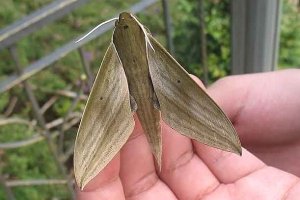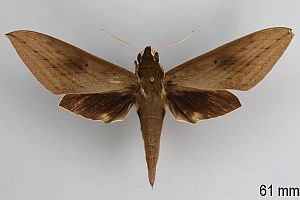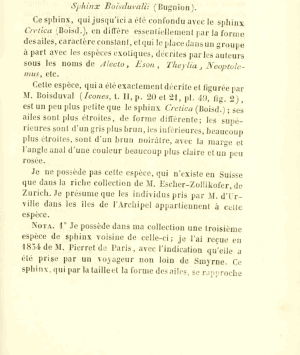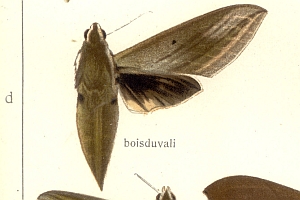

 +13Kontinente:EUAS
+13Kontinente:EUAS1. Lebendfotos
1.1. Falter
2. Diagnose
2.1. Männchen
2.2. Weibchen
2.3. Erstbeschreibung
3. Weitere Informationen
3.1. Andere Kombinationen
- Sphinx boisduvalii Bugnion, 1839 [Originalkombination]
3.2. Synonyme
- Chaerocampa punctivenata Butler, 1875
- Cechenena sumatrensis Joicey & Kaye, 1917
3.3. Faunistik
Die Art wurde aus Kreta beschrieben, die Art scheint heute aber weder dort noch sonstwo in Europa vorzukommen. In der Fauna Europaea (Fauna Europaea Web Service. Last update 22 December 2009. Version 2.1. [nicht mehr online verfügbar]) ist dazu zu lesen: "In the original description of Sphinx cretica, Boisduval confused two species. Bugnion renamed the second of these as Sphinx boisduvalii. The type locality of Sphinx boisduvalii is Crete but it is highly unlikely that the species exists there now, even as a very rare vagrant."
Danner et al. (1998) schreiben zur Verbreitung der Art: "Als fakultativer Wanderer kann diese Art Kleinasien und möglicherweise auch Europa erreichen. Bodenständig ist sie vom Südosten des Iran über Indien ... und Sri Lanka, in Südostasien bis Borneo".
Pittaway([http://tpittaway.tripod.com/sphinx/t_boi.htm] Last updated on: 17 January 2010) schreibt zum möglichen Vorkommen in Europa: "A rare migrant to south-eastern Iran, and thence possibly westwards as a very rare vagrant to Turkey and Greece. No individuals have been recorded from Europe in recent years. As T. boisduvalii and T. alecto have both shared the name cretica, it may be that many 'records' of this species from Europe are due to misunderstanding."
3.4. Literatur
- Erstbeschreibung: Bugnion (1839): Note sur le Sphinx cretica. — Annales de la Société etnomologique de France 8: 113-116. Paris (Pitois-Levrault et Cie.).
- Seitz, A. (Hrsg.) (1909-1914). Die Gross-Schmetterlinge der Erde. Band 2: I-VII, 1-479, pl. 1-56. Stuttgart (Fritz Lehmann Verlag).





















